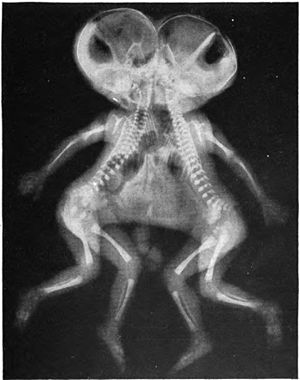Conjoined twins
| Conjoined twins | |
|---|---|
 |
|
| X-ray of conjoined twins, cephalothoracopagus. | |
| Classification and external resources | |
| Specialty | medical genetics |
| ICD-10 | O33.7, Q89.4 |
| ICD-9-CM | 678.1, 759.4 |
| DiseasesDB | 34474 |
| eMedicine | ped/2936 |
| MeSH | D014428 |
Conjoined twins are identical twins joined in utero. An extremely rare phenomenon, the occurrence is estimated to range from 1 in 49,000 births to 1 in 189,000 births, with a somewhat higher incidence in Southeast Asia and Africa. Approximately half are stillborn, and an additional one-third die within 24 hours. Most live births are female, with a ratio of 3:1. Most stillborns are male.
Two contradicting theories exist to explain the origins of conjoined twins. The more generally accepted theory is fission, in which the fertilized egg splits partially. The other theory, no longer believed to be the basis of conjoined twinning, is fusion, in which a fertilized egg completely separates, but stem cells (which search for similar cells) find like-stem cells on the other twin and fuse the twins together. Conjoined twins share a single common chorion, placenta, and amniotic sac, although these characteristics are not exclusive to conjoined twins as there are some monozygotic but non-conjoined twins who also share these structures in utero.
The most famous pair of conjoined twins was Chang and Eng Bunker (Thai: อิน-จัน, In-Chan) (1811–1874), Thai brothers born in Siam, now Thailand. They traveled with P.T. Barnum's circus for many years and were labeled as the Siamese Twins. Chang and Eng were joined by a band of flesh, cartilage, and their fused livers at the torso. In modern times, they could have been easily separated. Due to the brothers' fame and the rarity of the condition, the term "Siamese twins" came to be used as a synonym for conjoined twins.
Conjoined twins are typically classified by the point at which their bodies are joined. The most common types of conjoined twins are:
Other less-common types of conjoined twins include:
Surgery to separate conjoined twins may range from very easy to very difficult depending on the point of attachment and the internal parts that are shared. Most cases of separation are extremely risky and life-threatening. In many cases, the surgery results in the death of one or both of the twins, particularly if they are joined at the head or share a vital organ. This makes the ethics of surgical separation, where the twins can survive if not separated, contentious. Alice Dreger of Northwestern University found the quality of life of twins who remain conjoined to be higher than is commonly supposed.Lori and George Schappell and Abby and Brittany Hensel are notable examples.
...
Wikipedia
